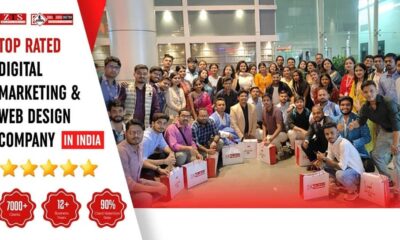TECHNOLOGY
Debunking the top myths about cloud-based physical security

Over the years, cloud-based physical security technology has been increasing in power and popularity as many businesses have begun to favour the cloud over on-premises systems. According to cloud security company Thales, 90% of companies worldwide use the cloud. The cloud is essential to data management for most businesses and there are many reasons why.
Cloud-based technology is sweeping the security industry because of its advanced abilities and unparalleled convenience. However, there is a lot of miscommunication and misunderstanding about how the cloud works. Here are some of the most common myths that are holding businesses back from investing in cloud-based physical security so you can see the actual value of the cloud.
1. Cloud systems are more expensive
Physical security technology is often a large investment, whether you need to secure a single office or an entire multi-site enterprise. While the advanced features of physical security systems may mean a high up-front cost, cloud-based technology has long-term ROI that shouldn’t be overlooked.
Updating software and systems is key to keeping your security ahead of the latest vulnerabilities. Cloud-based providers like Openpath automatically upgrade over-the-air without in-person maintenance, which can be beneficial when looking at long-term costs. Plus, because the system is easy to update with the latest and greatest, you’re getting the most advanced security features without having to replace the entire system.
Business needs change over time, so it’s important to consistently evaluate your security systems to see if you need to add or remove features. The benefit of the cloud is that software is generally scalable, allowing you to pay for what you use rather than locking in a long-term contract at installation, which is an effective way to keep your costs in check.
Management is also something many businesses don’t factor into long-term costs. Traditional on-premise security systems may require hiring dedicated staff at each location or office to manage them, and for systems like access control, there’s often ongoing costs to issue and replace key card and fob credentials. Migrating to the cloud enables fully remote management, and mobile-based credentials that are less cumbersome for both staff and users.
The cloud can change how your security system operates by saving costs over time, reducing workloads, and providing better security to your business.
2. You don’t have to manage the cloud
The ongoing maintenance and management of your cloud security system is not the sole responsibility of the vendor; it is a shared responsibility. How responsibility is shared depends on the cloud system and the service provider. With most cloud-based providers, managing and maintaining the server is the responsibility of a third party. It’s important to choose providers that are transparent about their own security measures, such as employing end-to-end encryption, following cybersecurity best practices, and limiting account permissions.
That doesn’t mean your business is totally off the hook, though. You are still in charge of managing your own applications and data security. This means that you need an effective and knowledgeable security team to manage your cloud security system if you want to keep it secure. After all, you wouldn’t want to release sensitive data due to poor data security.
The advantage of sharing cloud management responsibility is that you reduce your burdens while gaining greater flexibility. You can adjust the applications to your needs without purchasing, updating, or hiring IT personnel to manage additional servers, making it easy to scale your physical security system as your business grows.
3. The cloud is just for storage
Many people associate the cloud with mobile phone data storage, but successful businesses will know that the cloud is capable of far more. The cloud can easily manage physical security technologies, from an intercom system and keyless access control, to video security.
Beyond storing limitless system data, cloud-based physical security allows businesses to manage their security remotely and efficiently. Companies can integrate their security systems, manage technologies via one network, and use automation for faster responses with the cloud. This provides businesses with the flexibility to scale their security systems up or back with greater ease.
4. You only need cybersecurity for the cloud
Since the cloud runs on the Internet, surely you should only need cybersecurity to protect the data kept on it? Wrong. Physical security is equally essential as cybersecurity in preventing data breaches. Truthfully, the best way to protect your cloud is to converge your physical and cybersecurity systems for a complete level of protection.
In the cloud, cybersecurity measures handle passwords, authentication, and encryption, essentially protecting your data from digital access. However, physical security protects computers, servers, and sensitive information from physical access breaches that could place sensitive data at risk.
One example is using cloud-based physical security to monitor building access. This protects the business from losing data via physical access, while cybersecurity protects the virtual side. Leveraging cloud-based security systems like Openpath access control enables businesses to easily migrate to converged physical and digital security. For example, Openpath’s real-time access logs can be integrated with data analytics to help security teams identify a potential breach that threatens confidential information. Being able to identify threats faster is crucial in a security breach situation, and having connected systems allows security teams to act quickly and mitigate risks before they pose a greater problem.
Want to learn more about cloud computing from industry leaders? Check out Cyber Security & Cloud Expo taking place in Amsterdam, California and London.
Explore other upcoming enterprise technology events and webinars powered by TechForge here.
Source link
TECHNOLOGY
Next-gen chips, Amazon Q, and speedy S3

AWS re:Invent, which has been taking place from November 27 and runs to December 1, has had its usual plethora of announcements: a total of 21 at time of print.
Perhaps not surprisingly, given the huge potential impact of generative AI – ChatGPT officially turns one year old today – a lot of focus has been on the AI side for AWS’ announcements, including a major partnership inked with NVIDIA across infrastructure, software, and services.
Yet there has been plenty more announced at the Las Vegas jamboree besides. Here, CloudTech rounds up the best of the rest:
Next-generation chips
This was the other major AI-focused announcement at re:Invent: the launch of two new chips, AWS Graviton4 and AWS Trainium2, for training and running AI and machine learning (ML) models, among other customer workloads. Graviton4 shapes up against its predecessor with 30% better compute performance, 50% more cores and 75% more memory bandwidth, while Trainium2 delivers up to four times faster training than before and will be able to be deployed in EC2 UltraClusters of up to 100,000 chips.
The EC2 UltraClusters are designed to ‘deliver the highest performance, most energy efficient AI model training infrastructure in the cloud’, as AWS puts it. With it, customers will be able to train large language models in ‘a fraction of the time’, as well as double energy efficiency.
As ever, AWS offers customers who are already utilising these tools. Databricks, Epic and SAP are among the companies cited as using the new AWS-designed chips.
Zero-ETL integrations
AWS announced new Amazon Aurora PostgreSQL, Amazon DynamoDB, and Amazon Relational Database Services (Amazon RDS) for MySQL integrations with Amazon Redshift, AWS’ cloud data warehouse. The zero-ETL integrations – eliminating the need to build ETL (extract, transform, load) data pipelines – make it easier to connect and analyse transactional data across various relational and non-relational databases in Amazon Redshift.
A simple example of how zero-ETL functions can be seen is in a hypothetical company which stores transactional data – time of transaction, items bought, where the transaction occurred – in a relational database, but use another analytics tool to analyse data in a non-relational database. To connect it all up, companies would previously have to construct ETL data pipelines which are a time and money sink.
The latest integrations “build on AWS’s zero-ETL foundation… so customers can quickly and easily connect all of their data, no matter where it lives,” the company said.
Amazon S3 Express One Zone
AWS announced the general availability of Amazon S3 Express One Zone, a new storage class purpose-built for customers’ most frequently-accessed data. Data access speed is up to 10 times faster and request costs up to 50% lower than standard S3. Companies can also opt to collocate their Amazon S3 Express One Zone data in the same availability zone as their compute resources.
Companies and partners who are using Amazon S3 Express One Zone include ChaosSearch, Cloudera, and Pinterest.
Amazon Q
A new product, and an interesting pivot, again with generative AI at its core. Amazon Q was announced as a ‘new type of generative AI-powered assistant’ which can be tailored to a customer’s business. “Customers can get fast, relevant answers to pressing questions, generate content, and take actions – all informed by a customer’s information repositories, code, and enterprise systems,” AWS added. The service also can assist companies building on AWS, as well as companies using AWS applications for business intelligence, contact centres, and supply chain management.
Customers cited as early adopters include Accenture, BMW and Wunderkind.
Want to learn more about cybersecurity and the cloud from industry leaders? Check out Cyber Security & Cloud Expo taking place in Amsterdam, California, and London. Explore other upcoming enterprise technology events and webinars powered by TechForge here.
TECHNOLOGY
HCLTech and Cisco create collaborative hybrid workplaces

Digital comms specialist Cisco and global tech firm HCLTech have teamed up to launch Meeting-Rooms-as-a-Service (MRaaS).
Available on a subscription model, this solution modernises legacy meeting rooms and enables users to join meetings from any meeting solution provider using Webex devices.
The MRaaS solution helps enterprises simplify the design, implementation and maintenance of integrated meeting rooms, enabling seamless collaboration for their globally distributed hybrid workforces.
Rakshit Ghura, senior VP and Global head of digital workplace services, HCLTech, said: “MRaaS combines our consulting and managed services expertise with Cisco’s proficiency in Webex devices to change the way employees conceptualise, organise and interact in a collaborative environment for a modern hybrid work model.
“The common vision of our partnership is to elevate the collaboration experience at work and drive productivity through modern meeting rooms.”
Alexandra Zagury, VP of partner managed and as-a-Service Sales at Cisco, said: “Our partnership with HCLTech helps our clients transform their offices through cost-effective managed services that support the ongoing evolution of workspaces.
“As we reimagine the modern office, we are making it easier to support collaboration and productivity among workers, whether they are in the office or elsewhere.”
Cisco’s Webex collaboration devices harness the power of artificial intelligence to offer intuitive, seamless collaboration experiences, enabling meeting rooms with smart features such as meeting zones, intelligent people framing, optimised attendee audio and background noise removal, among others.
Want to learn more about cybersecurity and the cloud from industry leaders? Check out Cyber Security & Cloud Expo taking place in Amsterdam, California, and London. Explore other upcoming enterprise technology events and webinars powered by TechForge here.
TECHNOLOGY
Canonical releases low-touch private cloud MicroCloud

Canonical has announced the general availability of MicroCloud, a low-touch, open source cloud solution. MicroCloud is part of Canonical’s growing cloud infrastructure portfolio.
It is purpose-built for scalable clusters and edge deployments for all types of enterprises. It is designed with simplicity, security and automation in mind, minimising the time and effort to both deploy and maintain it. Conveniently, enterprise support for MicroCloud is offered as part of Canonical’s Ubuntu Pro subscription, with several support tiers available, and priced per node.
MicroClouds are optimised for repeatable and reliable remote deployments. A single command initiates the orchestration and clustering of various components with minimal involvement by the user, resulting in a fully functional cloud within minutes. This simplified deployment process significantly reduces the barrier to entry, putting a production-grade cloud at everyone’s fingertips.
Juan Manuel Ventura, head of architectures & technologies at Spindox, said: “Cloud computing is not only about technology, it’s the beating heart of any modern industrial transformation, driving agility and innovation. Our mission is to provide our customers with the most effective ways to innovate and bring value; having a complexity-free cloud infrastructure is one important piece of that puzzle. With MicroCloud, the focus shifts away from struggling with cloud operations to solving real business challenges” says
In addition to seamless deployment, MicroCloud prioritises security and ease of maintenance. All MicroCloud components are built with strict confinement for increased security, with over-the-air transactional updates that preserve data and roll back on errors automatically. Upgrades to newer versions are handled automatically and without downtime, with the mechanisms to hold or schedule them as needed.
With this approach, MicroCloud caters to both on-premise clouds but also edge deployments at remote locations, allowing organisations to use the same infrastructure primitives and services wherever they are needed. It is suitable for business-in-branch office locations or industrial use inside a factory, as well as distributed locations where the focus is on replicability and unattended operations.
Cedric Gegout, VP of product at Canonical, said: “As data becomes more distributed, the infrastructure has to follow. Cloud computing is now distributed, spanning across data centres, far and near edge computing appliances. MicroCloud is our answer to that.
“By packaging known infrastructure primitives in a portable and unattended way, we are delivering a simpler, more prescriptive cloud experience that makes zero-ops a reality for many Industries.“
MicroCloud’s lightweight architecture makes it usable on both commodity and high-end hardware, with several ways to further reduce its footprint depending on your workload needs. In addition to the standard Ubuntu Server or Desktop, MicroClouds can be run on Ubuntu Core – a lightweight OS optimised for the edge. With Ubuntu Core, MicroClouds are a perfect solution for far-edge locations with limited computing capabilities. Users can choose to run their workloads using Kubernetes or via system containers. System containers based on LXD behave similarly to traditional VMs but consume fewer resources while providing bare-metal performance.
Coupled with Canonical’s Ubuntu Pro + Support subscription, MicroCloud users can benefit from an enterprise-grade open source cloud solution that is fully supported and with better economics. An Ubuntu Pro subscription offers security maintenance for the broadest collection of open-source software available from a single vendor today. It covers over 30k packages with a consistent security maintenance commitment, and additional features such as kernel livepatch, systems management at scale, certified compliance and hardening profiles enabling easy adoption for enterprises. With per-node pricing and no hidden fees, customers can rest assured that their environment is secure and supported without the expensive price tag typically associated with cloud solutions.
Want to learn more about cybersecurity and the cloud from industry leaders? Check out Cyber Security & Cloud Expo taking place in Amsterdam, California, and London. Explore other upcoming enterprise technology events and webinars powered by TechForge here.
-

 MARKETING6 days ago
MARKETING6 days agoRoundel Media Studio: What to Expect From Target’s New Self-Service Platform
-

 SEO6 days ago
SEO6 days agoGoogle Limits News Links In California Over Proposed ‘Link Tax’ Law
-
SEARCHENGINES6 days ago
Daily Search Forum Recap: April 12, 2024
-

 SEO5 days ago
SEO5 days ago10 Paid Search & PPC Planning Best Practices
-

 SEARCHENGINES5 days ago
SEARCHENGINES5 days agoGoogle Core Update Volatility, Helpful Content Update Gone, Dangerous Google Search Results & Google Ads Confusion
-

 SEO7 days ago
SEO7 days agoGoogle Unplugs “Notes on Search” Experiment
-

 MARKETING5 days ago
MARKETING5 days ago2 Ways to Take Back the Power in Your Business: Part 2
-

 PPC6 days ago
PPC6 days agoCritical Display Error in Brand Safety Metrics On Twitter/X Corrected















You must be logged in to post a comment Login